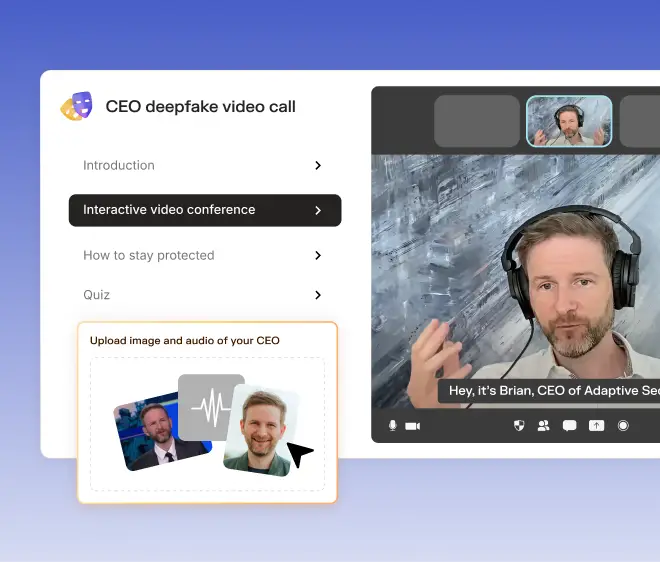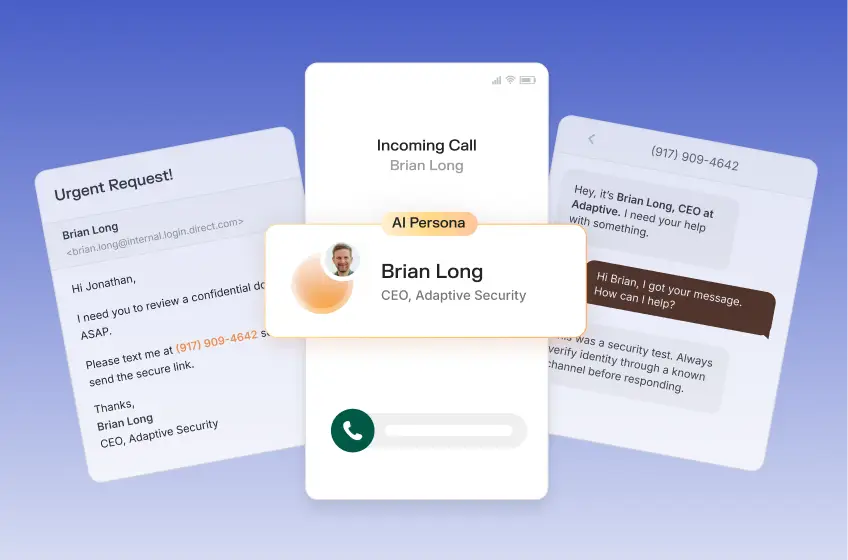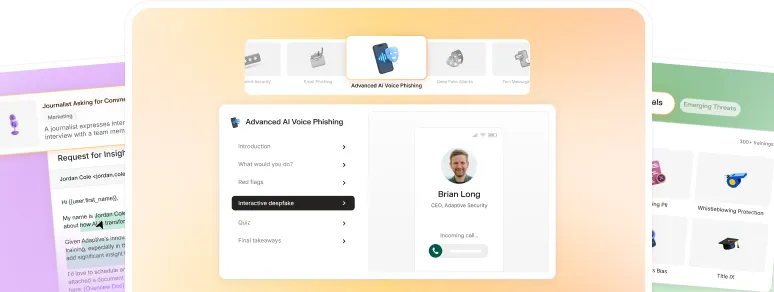Predictable nuisance? Not anymore. Executive impersonation has evolved into a sophisticated, AI-accelerated crisis.
The threat is escalating at an alarming pace.
What was once a simple business email compromise (BEC) attack is now a multi-channel assault using deepfake video and AI voice cloning that bypasses endpoint security and exploits human trust.
40% of IT and security professionals say an executive was targeted in a deepfake attack in 2025, up from just one-third in 2023. In parallel, vishing attacks surged by 170% in the second quarter of 2025 alone.
For CISOs, protecting every employee — from the front lines to the C-suite — has become an increasingly complex challenge.
This guide offers an evidence-based framework for developing a resilient defense against AI executive impersonation attacks. We’ll dissect the current threat landscape to show how AI enables impersonation at scale, before moving to methods for employees to detect executive impersonation. From there, we’ll detail the layered controls, organization-wide training programs, and incident response playbooks needed to improve security posture.
The defense against deepfake attacks must be as sophisticated as the threat itself, which requires combining technology with a human firewall fortified by next-generation security awareness training.
Understanding AI-Powered Executive Impersonation
Attackers no longer need to reach a firewall when they can simply walk through the front door by convincingly mimicking the face and voice of an executive.
Executive impersonation campaigns are designed to exploit the foundational elements of business operations: trust, urgency, and authority. It’s a tactic that directly targets business risk by manipulating employees into making fraudulent payments, transferring sensitive data, or granting unauthorized access.
To effectively counter this threat, understand the types of phishing attacks at the center of executive impersonation:
- Deepfake: AI-generated or AI-altered media — including video, images, or audio — that convincingly imitates a real person’s appearance or voice with the intent to deceive the audience.
- Vishing: A form of voice phishing, vishing uses phone calls or voice messages to trick targets.
- Business Email Compromise: A type of fraud where attackers impersonate through email phishing, aiming to trick employees into transferring funds or revealing confidential data.
- Whaling: Highly targeted phishing attacks aimed at senior executives or other high-profile individuals within an organization.
What’s clear is that attackers aren’t limited to a specific threat vector for executive impersonation, and they’re increasingly relying on deepfakes due to the level of success achieved through their hyper-realism.
How does AI enable impersonation at scale?
Generative AI provides attackers with a powerful, accessible pathway to automating and scaling executive impersonation attacks. What once required significant time and technical skill can now be done with minimal resources.
AI-powered phishing operations can be initiated for as little as $100. However, this will only decrease as the cost of AI continues to fall, fueling the surge in AI phishing.
The enabling technology stack for AI executive impersonation attacks includes several components, including:
- Generative Voice Cloning: Attackers produce a near-indistinguishable voice clone from just a few seconds of public audio, such as a podcast or webinar recording.
- Face-Swap & Reenactment Tools: Real-time video deepfake tools, such as Deep-Live-Cam, enable attackers to inject synthetic faces into live video calls, effectively hijacking an executive’s likeness.
- LLM-Powered Social Engineering: Large language models (LLMs) analyze scraped communications to generate personalized scripts that perfectly mirror an executive’s tone, timing, and common requests.
- Automation & Distribution: AI enables attackers to orchestrate multi-channel campaigns across email, video, voice, SMS, and collaboration apps like Microsoft Teams or Slack, increasing their success rates.
Previously, carrying out sophisticated social engineering required time-consuming, manual work to develop the necessary materials. Now, it takes a fraction of the time and cost.
Common attacks across communication channels
AI allows attackers to launch coordinated attacks across multiple channels, so understanding the threat vectors is the first step toward building an effective defense for all employees.
The good news is that a handful of top security awareness training platforms, including Adaptive Security, directly address phishing attacks across all these channels (and more).
Business risks and real-world patterns
The business risks associated with AI executive impersonation are substantial. Phishing attacks result in billions of dollars in losses annually, and the average cost of a data breach exceeds $4 million. But it’s often dramatically worse when an organization falls victim to an AI executive impersonation attack.
In 2024, Arup lost $25 million after attackers used a deepfake of the chief financial officer (CFO) to swindle a finance employee during a video conference.
The biggest problem is that attack patterns are shifting. Modern phishing campaigns typically feature:
- Multi-channel escalation
- Targeting of employees with access to key systems
- Vendor payment diversion
All the while, legacy solutions for security awareness training haven’t kept up. However, CISOs and security teams at leading brands are quickly transitioning to next-generation platforms to bring AI phishing, such as executive impersonation, to the forefront of training.
How to Detect Executive Impersonation
Detection requires a layered mindset that empowers employees to verify identity, intent, and channel integrity simultaneously. This involves combining human observation with technology and strict verification protocols.
A key concept in the process is liveness detection, which uses a set of signals — think challenge-response tests, micro-expressions, and acoustic analysis — to confirm a real human is present rather than a deepfake.
How to detect a deepfake
When facing a potential deepfake on a live video or phone call, employees should use this checklist to assess its authenticity:
- Initiate a Liveness Challenge: Ask the ‘executive’ to perform an unpredictable gesture, such as turning their head fully to the side, waving a hand in front of their face, or saying a random phrase.
- Probe for Temporal Artifacts: Look for visual inconsistencies that AI models struggle with, such as a lag between lip movements and audio, irregular eye-blinking patterns, or a stiff head pose.
- Analyze Audio Anomalies: Listen for robotic or unnatural rhythm and intonation, odd breath patterns, or spectral artifacts. Interrupting the speaker can often cause AI models to glitch.
- Cross-Verify Metadata & Context: Check that the meeting invitation originated from a legitimate corporate calendar entry and that the request aligns with historical communication patterns.
- Use Detection Tools When Available: If your organization deployed deepfake detection services, run the media through them to get a confidence score and document the outcome.
Remember that detection isn’t perfect, so always combine tool-based analysis with strict internal verification workflows to minimize risk.
Verification workflows for video meetings and phone calls
To validate requests during live interactions without creating excessive friction, all employees must be trained on a high-confidence verification workflow.
- Out-of-Band Callback: End the current session and contact the executive back using a pre-validated phone number stored in a secure company directory.
- Pre-Shared Code Phrases: Use rotating weekly or daily code phrases known only to the executive and key personnel to verify identity during sensitive requests.
- Dual-Approval for High-Risk Actions: Mandate that a second executive or financial controller sign off on all large wire transfers or access escalations.
Implementing these simple but effective workflows provides a powerful backstop against even the most convincing deepfakes.
Red flags in email, SMS, and collaboration apps
Executive impersonation occurs through text-based communication as well, and so employees should watch for a handful of high-signal indicators of a phishing attack.
- Identify Anomalies: Look for display-name spoofing, lookalike domains, and authentication failures.
- Questionable Behavior: Be wary of unusual timing (such as late-night requests), an atypical tone, sudden urgency, or demands for secrecy. Comparing the request against a digital fingerprint helps spot any deviations.
- Delivery Artifacts: Suspicious signs include the use of link shorteners, unexpected links to cloud files, and threads originating from mobile-only devices.
Vigilance across these text-based channels is crucial, as they’re often used to initiate or add legitimacy to a broader multi-channel attack.
Stop Attacks with Layered Controls & Tools
Because detection is imperfect and attackers iterate rapidly, a layered defense strategy is essential. Any controls and tools should span every channel, with an emphasis on automation and correlating signals.
Tools to prevent AI-powered executive impersonation attacks
To combat these threats, organizations must deploy a security stack designed for the AI era.
Several categories of tools help prevent, detect, and respond to impersonation attacks:
- Security Awareness Training & Phishing Simulations: Equip employees with the knowledge they need to recognize and respond to AI threats across all channels.
- Email Authentication & Anomaly Detection: Enforce DMARC, SPF, and DKIM to prevent domain spoofing, and use machine learning (ML) to flag deviations in an executive’s typical email tone, request types, and sending patterns.
- Mobile & Collaboration Protection: Deploy solutions that detect impersonation attempts across chat platforms while also monitoring a mobile device’s overall risk posture.
- Deepfake Detection: Use specialized technology to scan video and voice streams for signs of manipulation. In addition, monitor the web for impersonation content and issue takedown requests.
- Executive Communications Fingerprinting: Implement tools that build behavioral baselines of executive communications to automatically flag unusual timing, language, or requests.
The following table provides examples of vendors that offer these capabilities.
Selecting the right combination of tools provides a strong foundation for your defense strategy.
Executive identify, device, and brand protection controls
A holistic protection strategy includes managing the executive’s digital footprint, as they’re the source of the impersonation material.
Each of these controls works together to reduce the available material for attackers and create procedural roadblocks to stop attacks in progress.
Build an Organization-Wide Training Program
Any impactful defense will be born out of treating training as a control equal in importance to technology, with a focus on preparing all employees — especially those in high-risk roles — for executive impersonation scenarios.
3 steps CISOs should take right now
CISOs can take immediate, structured action to begin building a more resilient organization.
Here’s a multi-step 90-day plan to help CISOs systematically harden the organization:
- Days 1-30 | Assess: Conduct a risk assessment and inventory the digital footprint of key leaders to understand the available attack surface, then establish baseline verification policies for all employees.
- Days 31-60 | Deploy: Roll out layered technical controls across communication channels. Implement a code-phrase system for high-risk teams and strengthen payment controls organization-wide.
- Days 61-90 | Test & Refine: Run phishing simulations targeting key departments (such as finance, HR, and legal) with deepfakes of executives. Tune detection tool thresholds, finalize incident response playbooks, and establish a board-level reporting cadence.
Overall, this plan provides a clear roadmap from initial assessment to a mature, tested defense posture.
How training prevents executive impersonation attacks
Security awareness training is a cornerstone of defense against AI-powered executive impersonation. Employees receive role-based training with hyper-realistic phishing simulations across every channel.
Here’s what to focus on for your program to ensure employees receive relevant, engaging training:
By focusing on these areas, you move beyond simple awareness to build lasting, secure behaviors throughout the organization.
Running effective phishing simulations
Phishing simulations sent to employees to train against executive impersonation must be highly realistic and context-aware, so here’s what that should look like:
- Email Phishing Attacks: Use pretexts that mimic an executive’s tone and timing (such as end-of-quarter pressure) with relevant scenarios like vendor bank changes.
- Vishing Attacks: Send calls using AI voice cloning that convey urgency, requiring the employee to perform a callback verification to pass the test.
- Deepfake Attacks: Engage employees with a deepfake of an executive to assess their ability to perform a liveness challenge.
The goal of these phishing simulations is not to trick employees. Instead, it’s to provide a safe environment for practicing and reinforcing the correct verification procedures.
Respond & Measure with an Executive Impersonation Playbook
A dedicated, role-based playbook is critical for responding to a deepfake attack. It should align with any existing incident response plan procedures but include deepfake-specific containment and evidence preservation steps.
Contain and recover from a live deepfake
If an employee suspects a deepfake during a meeting or phone call, they should take the following steps immediately:
- Terminate & Verify: End the session and perform an out-of-band callback using a known, trusted phone number.
- Freeze Risk: Pause all related payments, disable new vendor entries, lock the relevant user accounts, and quarantine any suspect messages or files.
- Switch Channels: Move communication to a known-good channel (such as a secure phone bridge) and inform the impersonated executive’s assistant or team, as well as the finance lead.
These immediate actions can prevent or minimize financial and data loss.
Evidence preservation, notifications, and legal coordination
Properly handling evidence is crucial for investigation and potential legal action.
- Collect & Preserve: Save all raw media files, call logs, email headers, and chat exports. Compute hashes to ensure integrity and capture details about the environment (such as device, operating system, and network).
- Maintain Chain of Custody: Keep detailed access logs and custody records for any evidence that may be shared with law enforcement.
- Coordinate with Legal: Always follow jurisdictional laws regarding call recording and consent, and display banners or provide verbal notice as required.
A well-documented process ensures that evidence is admissible and useful for both internal review and external reporting.
Metrics to track verification behaviors and risk reduction
Providing the value of phishing training for employees starts with tracking the right metrics.
To demonstrate the program’s effectiveness, tracking the following key performance indicators (KPIs):
- Verification before approval rate and time-to-verify for high-risk requests.
- Simulation pass rate and report rate across multi-channel tests.
- Detection precision and recall, false positive rate, and real-time latency from tools.
- Fraud prevented (in dollars), a downward trend in policy exceptions, and improvements in mean time to detect/respond.
Tracking these KPIs provides a clear, data-driven view of your organization’s resilience and the return on investment (ROI) of your efforts.
The New Mandate: Organization-Wide Security Awareness
Gone are the days of implicitly trusting a familiar face on a video meeting or a familiar voice over the phone. AI-powered executive impersonation is a present, persistent threat for 2025 and beyond.
Legacy cybersecurity models that focus solely on network perimeters or standard email filtering are insufficient against these attacks that so convincingly mimic human identity to exploit trust, authority, and urgency.
As detailed, an effective defense is a multi-layered strategy. It requires combining detection technology, stringent zero-trust verification workflows like out-of-band callbacks and code phrases, and organization-wide training. Technological and procedural guardrails are essential for creating a security posture that’s resilient against all AI threats.
Technology flags anomalies, but it’s a well-trained employee who serves as the last line of defense. Building this human firewall requires moving beyond passive awareness to active skill-building — a principle at the core of Adaptive Security’s mission.
Adaptive Security’s best-in-class platform provides role-based, multi-channel training and simulations for executive impersonation attacks, preparing the entire workforce to turn the most targeted employees into the most vigilant defenders.
Ready to detect and stop AI-powered executive impersonation? Get a demo with Adaptive Security to see why leading brands in every industry partner with us.




We are a team of passionate technologists. Adaptive is building a platform that’s tailor-made for helping every company embrace this new era of technology without compromising on security.
Contents



Want to download an asset from our site?








.avif)
.avif)
%20(1).avif)



